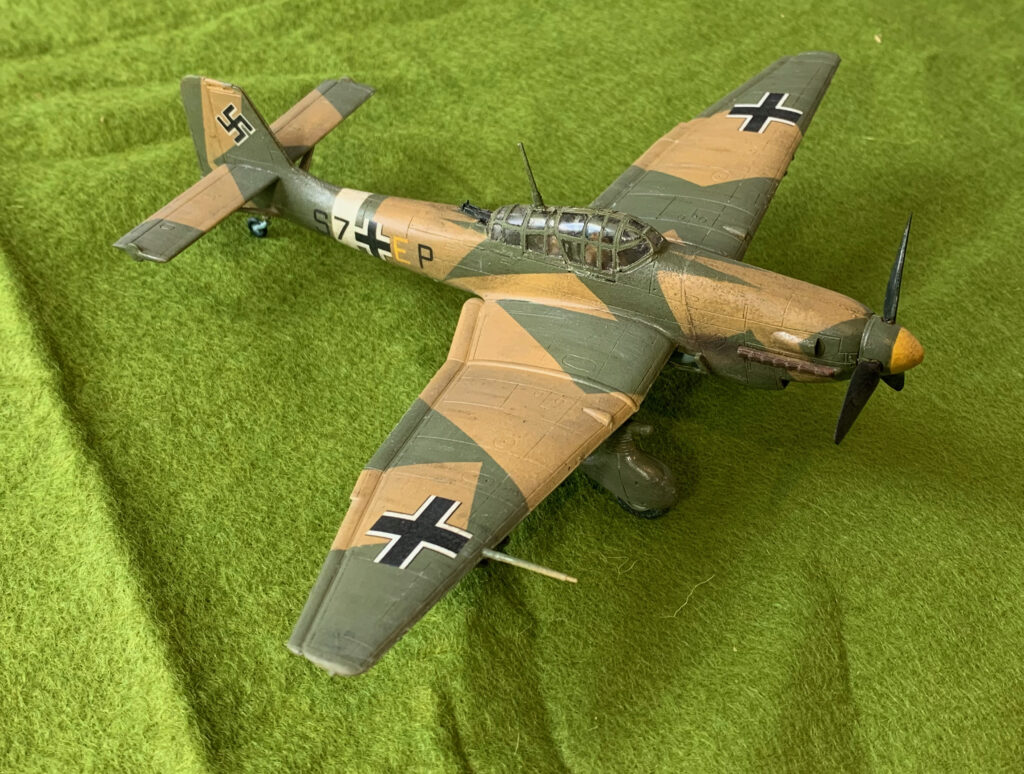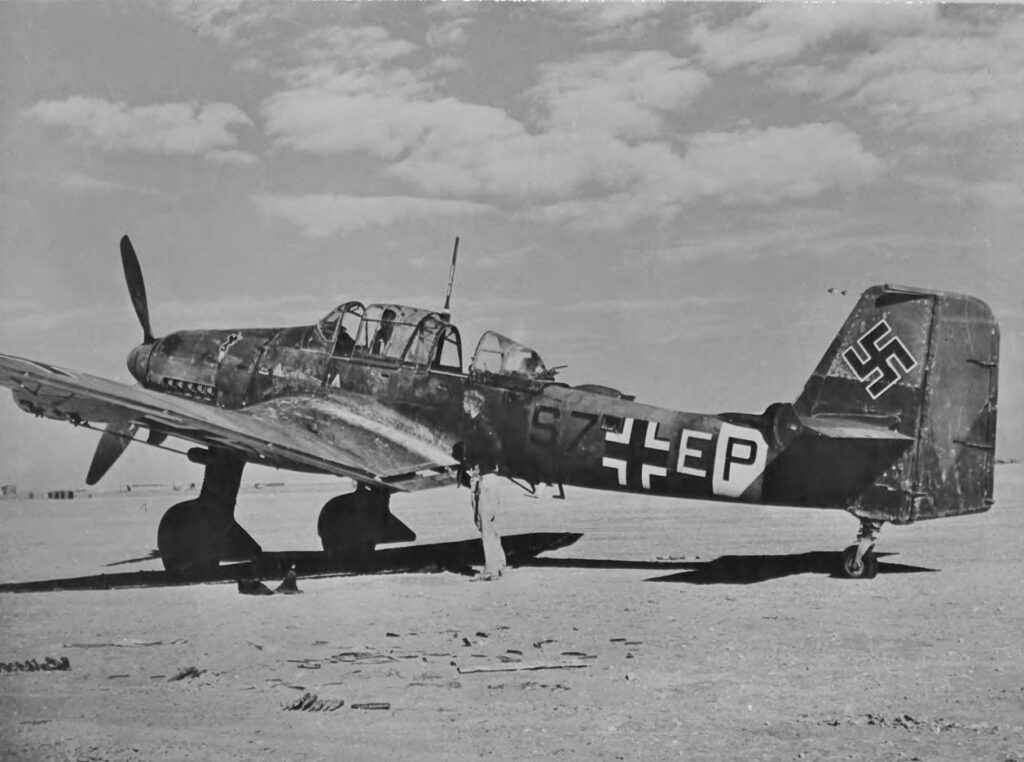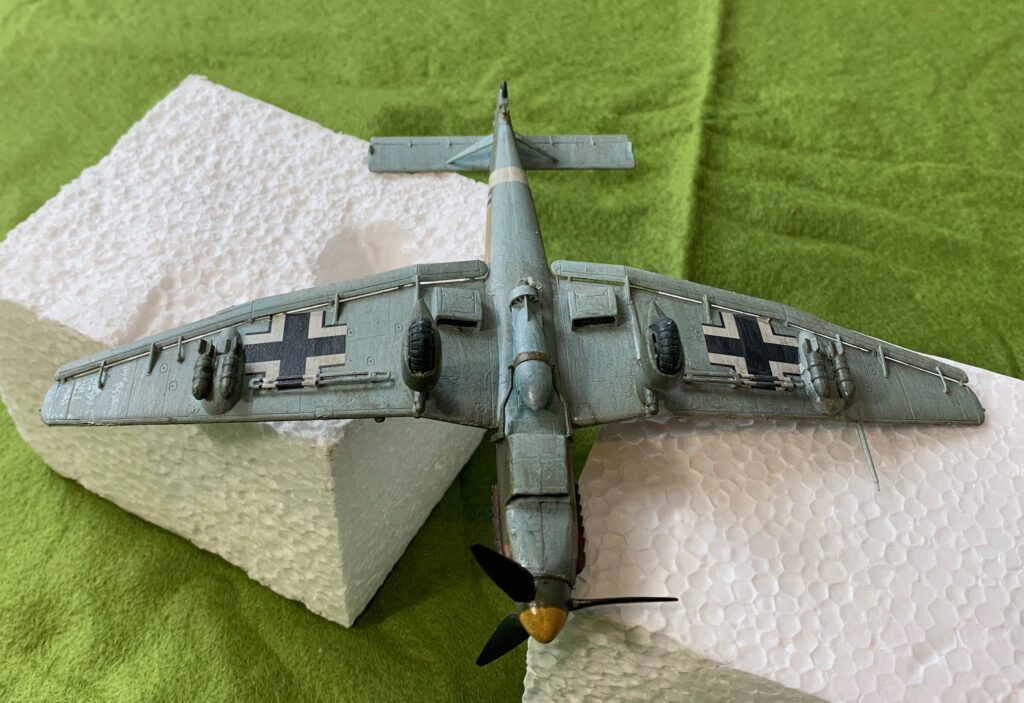
And so to the last of my trio of Luftwaffe models for Tunisia. I wanted a Stuka as it was such an iconic aircraft, and it certainly did make its presence felt on the battlefield in early 1943. But by then the plane that symbolised the terror of Blitzkrieg was obsolete. It was vulnerable to enemy fighters, and not that effective against dispersed troops and moving vehicles. Latterly the pilots only look them up when there was a lot of cloud cover, which didn’t help to find their targets. It was withdrawn to be used only well away from Allied air cover. This model proved quite hard work, however. At pretty much every stage it took me more time than the two fighter models put together.
For this project I needed a model for the D, or Dora, which had come into service during 1942. Most models are of the B, which was in service at height of the aircraft’s career. There was not a great deal of choice. If manufacturers prefer the B, their next choice is the G, a similar aircraft which saw extensive service on the Russian front later in 1943 as a tank buster, with two underwing 37mm cannon. This is very similar to the D, which does not have the cannon, but does have dive brakes and bomb pylons. There was a Hobby Boss model of the D, and for once the undercarriage would not have been a problem, but this was really an adapted G without the dive brakes. Instead the best reviewed option was this one from Hobby 2000. This was in fact a reissue of a much older (1990s) Fujimi model. All things equal I would have preferred a later D5 version which had longer wings and 20mm cannon in place of the wing machine guns. But Hobby 2000 had an issue for the D1 specifically covering North Africa, including decals and colour scheme for a rather interesting one with a splinter camouflage scheme with desert sand, featured on the box art. I also bought an Eduard stencil for the cockpit frame; this is complicated and I wanted to give this method a try. In fact one of the improvements that Hobby 2000 have made is to include a stencil of their own, so I have one spare! The model includes all the parts for a G1, the version based on the D1 (and often converted from it). Hobby 2000 also have an issue for the G2, which has the longer wings of the D5. This would need to substitute the (separate) wing sprue from this model to be accurate. The model does not include crew, which I supplied from resin models bought separately (I actually used US crew as stocks of Luftwaffe ones were low).

This model is quite different to the two fighters (or the Hobby Boss P-47) that I had made previously. This is partly because it was never intended as a quick-build, and partly, I suspect, because it is much older. The build was much more complicated. This included drilling holes in the wings to accommodate the dive brakes and bomb pylons – which I didn’t discover until after I had glued the top and bottom together, and had to rapidly pull them apart as this needed to be done from the inside. Mistakes like this didn’t help, but a bigger problem was that I didn’t find the parts to be especially well-fitting. And many of the smaller parts didn’t have clear recesses to fit them into. There was quite a bit of “How is this meant to work?”. A couple of parts I left out altogether. Quite a bit of model putty and filing was needed to cover up the gaps.I suspect that this is an area where model manufacturing standards have progressed. Back in the day (by which I mean the 1970s) I remember using a lot of putty. So assembly took a lot longer than the other models. Of course it is bigger and more complicated anyway.
Unlike the other models I decided to use the scheme and decals in the box. This showed a rather unusual splinter scheme. The box art said that the three colours used should be the three Luftwaffe desert colours of sand, olive green and azure blue. I though that this was rather unlikely. These paints would have been applied in theatre and replicating the complicated factory patterns was not done. Instead the whole upper parts were usually covered in sand, with blotches of olive green on top of that. Instead what I thought had happened was that the ground crew had just used sand to overpaint the black-green of the standard three colour splinter scheme the aircraft would have arrived in (dark green and light blue were the other colours). This was because I noticed from the box art that it was the sand was where the black-green was on the aircraft in the standard scheme. I used the same sand as the two fighters, and mixed the other colours specially. For the blue I started with the bright blue that came with my airbrush order, in the hope that I would create an airbrush friendly paint. Alas this was much too bright. I added a lot of white and brown to cool it down. I didn’t really succeed, I ended up with far too much paint and something too dark and too blue – it was hard to distinguish from the separately mixed azure I made for the Bf-109. The dark green was hard to judge. Studying pictures the contrast with black-green is not that great, so I was quite happy that I had a reasonably authentic colour. But there was a very strong contrast with the sand, when I had been hoping for something much closer to the box art.

I then saw another interpretation of this aircraft (S7+EP) in the Osprey book on Mediterranean Stukas (which arrived too late) in just the standard scheme. I have only just now discovered the source picture (above) and looks as if Osprey has it right. Look how the yellow E stands out and the black S7 doesn’t. I also made a mistake in the positioning of the white fuselage stripe, which I put further forward than it should have been. This was entirely my mistake as the box art had this right – though a lot of Stukas did have it in this more forward position. So that leaves me with an irony; this is the only plane I have made so far which is based on an authentic aircraft rather than a generic one – and I’ve got it wrong! Researching aircraft colour schemes is all part of the fun, but I’m learning it the hard way.
The paint was mainly applied with the airbrush. I had similar difficulties as the other planes with the paint consistency, but apart from spraying a bit of the green on the undersurfaces by accident (I though it would be easier to use the airbrush on the undercarriage than it was) I did not need much correction using the paintbrush. I achieved the splinter by applying the green over the sand, using masking tape. The tape took a long time to put on, but the effect is stunning, however unrealistic. Here is the underside:

Apart from the swastika I used the decals that came with them model. These proved quite hard to move into position, regardless of using generous quantities of fluid – much harder than for the other models or for the 40+ year old ones from stock. The underwing crosses were especially tricky as the air brakes and bomb pylons got in the way. A little cutting was needed. Hobby 2000 supplied the stripes to be applied on top of the air brakes (so that the cross comes out from below); these were a bit fiddly but not quite as hard to put on as I feared, and do look good.
I did the patination after my near-death experience on the fighter models, and I was very hesitant, after all the time I had already lavished on this model. So the upper surfaces look quite fresh, rather than trying to get anywhere near the weathered look you can see on the photo (though in that picture we don’t know how long the plane had been left abandoned for). Still the patination helps to integrate the colours and decals.
Another job that took quite a while on this model was the canopy, as there were many panels on the stencil to first put on and then take off. The result is OK but not better than would be achieved using the old-fashioned paintbrush method – albeit that acrylic paint doesn’t stick that well to the acetate, so you need a primer.
A lot of effort resulted in a nice-looking but unrealistic model, which is only relevant for the first part of my period. But you can’t have a collection of WW2 Luftwaffe aircraft without a Stuka.
Leave a Reply to admin Cancel reply